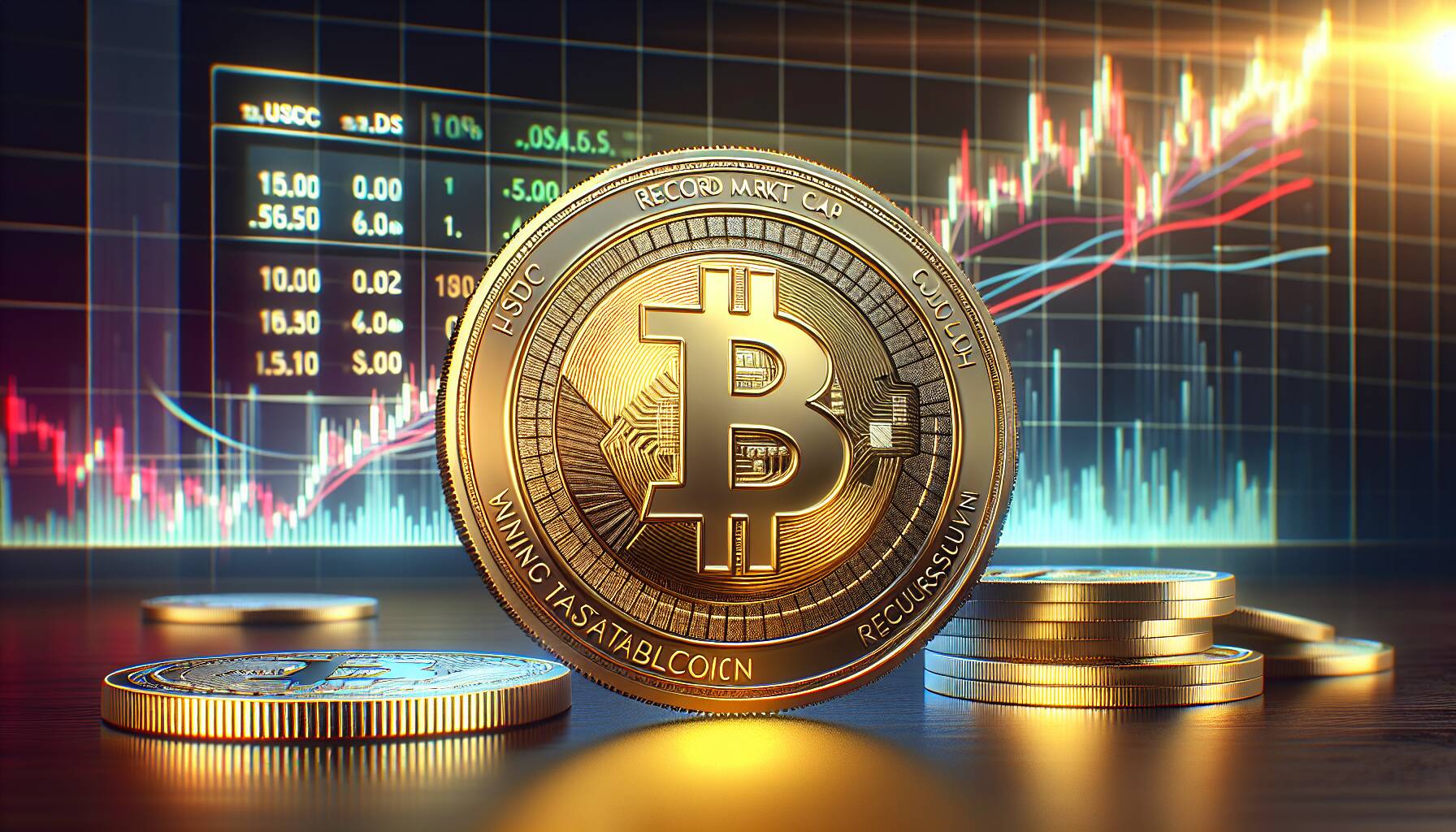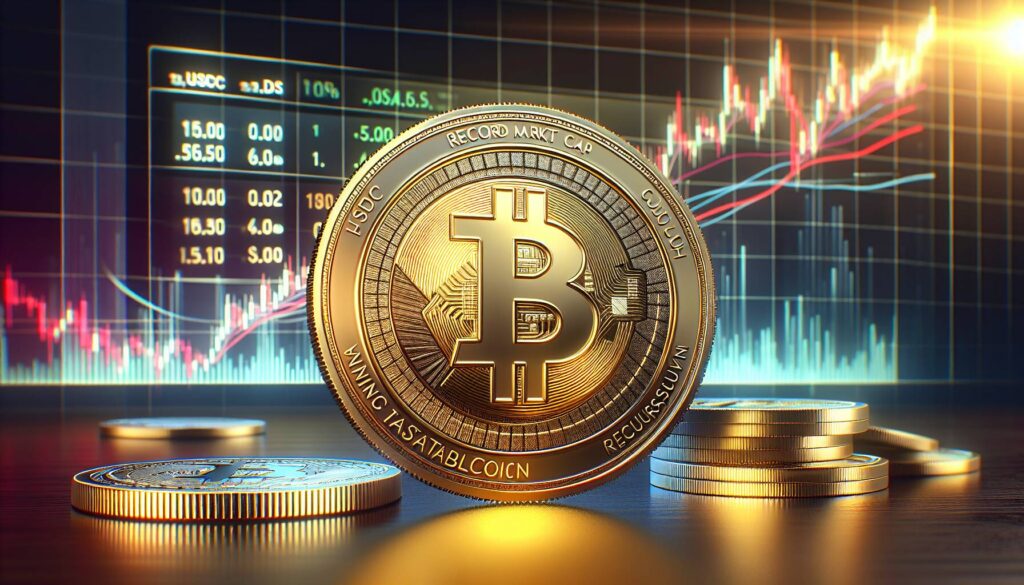This week, Circle’s USDC, the second-largest stablecoin by market capitalization, reached an impressive milestone by exceeding billion—a record that highlights a resurgence in the stablecoin sector. Over the past month, USDC’s market cap grew by .2 billion, a spike largely attributed to an increase in decentralized finance (DeFi) trading volumes on the Solana blockchain, according to data from Artemis. This growth far outpaces that of Tether’s USDT, the current market leader, which saw a .6 billion increase during the same timeframe.
Despite USDT still holding a commanding market cap of 2 billion, the rapid rise of USDC indicates a shift in investor sentiment, especially following a period of volatility triggered by the 2023 U.S. regional-banking crisis. During that tumultuous time, USDC suffered a setback due to its reserves being partly held in bank deposits at Silicon Valley Bank, which famously collapsed in a bank run. This event temporarily destabilized USDC’s peg to the U.S. dollar, prompting many investors to switch to USDT, which managed to hit its 2022 peak earlier this year.
Being a stablecoin means USDC and USDT are pegged to external assets—primarily the U.S. dollar—making them essential for trading on cryptocurrency exchanges and serving as a vital source of liquidity in the market. As demand for these digital dollars grows, their expanding supply signals renewed investor interest and a potential recovery in the overall health of the cryptocurrency market.
“With USDC’s recent growth, there are promising indicators of market revitalization, especially amidst general economic uncertainties,” said a market analyst. “Accelerating stablecoin growth often correlates with price hikes in Bitcoin and major altcoins.”
As stablecoin activity picks up after a quiet spell at the end of last year, observers are keenly monitoring these developments. Historically, surges in stablecoin growth have often preceded significant price rallies in the broader crypto space. The renewed momentum for USDC in particular paints an optimistic picture for the market landscape moving forward.

Key Insights on USDC’s Market Surge
The recent growth of USDC presents vital developments for cryptocurrency investors and users. Here are the key points that are shaping the landscape:
- Record Market Capitalization: USDC reached a historic market cap exceeding billion.
- Rapid Growth: An increase of .2 billion in the past month, fueled largely by Solana-based DeFi trading.
- Comparison with Competitors: USDT (Tether) saw a growth of .6 billion, indicating USDC’s significant market momentum.
- Recovery from Crisis: USDC has fully bounced back from the U.S. regional-banking crisis that temporarily affected its stability.
- Stablecoin Utility: Both USDC and USDT are crucial for trading on exchanges, serving as primary liquidity sources.
- Market Signals: Growth in stablecoins is a key indicator of demand and cryptocurrency market health, especially amidst external economic pressures.
- Cyclical Growth Patterns: Historical patterns show that stablecoin growth often correlates with increases in Bitcoin and altcoin prices.
The expansion of USDC signifies a reinvigoration in investor confidence, which could impact trading activities and investment strategies in the crypto space.
Understanding these dynamics can help readers navigate investment opportunities and gauge market trends effectively.
USDC’s Rising Dominance: A Deep Dive into Stablecoin Market Dynamics
This week, USDC, the prominent stablecoin by Circle, not only hit an impressive market capitalization exceeding billion but also emerged as a strong contender against its leading rival, Tether (USDT), which still holds the crown at 2 billion. The recent growth in the stablecoin sector can largely be attributed to a significant surge in decentralized finance (DeFi) trading volumes on the Solana network, revealing a dynamic shift in investor behavior. With USDC adding a substantial .2 billion to its market cap, its performance clearly outstripped USDT, which grew by .6 billion during the same timeframe.
Competitive Advantages:
USDC has notably rebounded from the setbacks of the 2023 U.S. regional banking crisis, showcasing resilience and reliability as it surpassed its previous 2022 peak. This recovery potentially fosters greater investor confidence, especially for those sidestepping risks associated with traditional banking systems. Furthermore, USDC’s alignment with DeFi growth indicates its utility in the flourishing decentralized marketplace, enhancing its appeal to investors seeking a secure and actively utilized stablecoin. With the rising tide of stablecoin utilization as a liquidity source on crypto exchanges, USDC’s growth pattern signals healthy investor demand, suggesting that the market may be poised for a broader resurgence.
Disadvantages and Challenges:
While USDC’s recent uptick is noteworthy, its journey isn’t without challenges. The lingering memory of the bank collapse that temporarily impaired USDC’s ability to maintain its peg has caused some potential investors to remain cautious. Additionally, Tether’s dominance presents a significant hurdle; despite USDC’s recent momentum, USDT’s established market presence provides it with competitive advantages in liquidity and trust among crypto traders. Consequently, USDC’s rapid growth might create tensions for USDT, potentially reshaping market dynamics and leading to a more competitive landscape.
Target Beneficiaries and Potential Problems:
This surge in USDC could greatly benefit developers and investors within the Solana ecosystem, providing enhanced opportunities for growth and liquidity. As institutions increasingly embrace DeFi solutions, USDC’s success could attract further institutional investments, potentially turning Solana into a favored platform for decentralized applications. However, for USDT, it may face a challenge in maintaining its user base as investors weigh their options, leading to possible loss of market share if USDC continues to outperform. Furthermore, the overall stability of the stablecoin market could become problematic if rapid shifts in liquidity occur, emphasizing the importance of balance between innovation and trust in the cryptocurrency landscape.

















